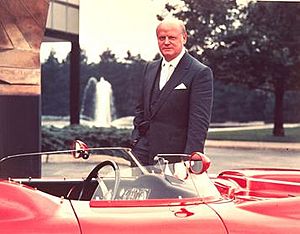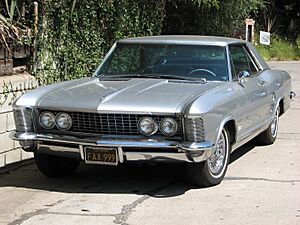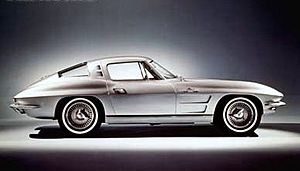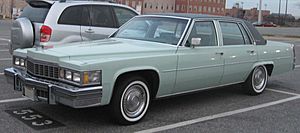Bill Mitchell (automobile designer) facts for kids
Quick facts for kids
William L. "Bill" Mitchell
|
|
|---|---|
 |
|
| Born | July 2, 1912 Cleveland, Ohio, U.S.
|
| Died | September 12, 1988 (aged 76) Royal Oak, Michigan, U.S.
|
| Nationality | American |
| Occupation | Automotive designer and executive |
| Known for | Head of design at General Motors 1958-1977; innovations in automotive design |
William L. Mitchell (born July 2, 1912, in Cleveland, Ohio; died September 12, 1988, in Royal Oak, Michigan) was a famous American car designer. He worked for General Motors (GM) for 42 years. He started there in 1935.
Mitchell helped design over 72.5 million cars made by GM. Some of his most famous designs include the 1963-65 Buick Riviera and the 1961-76 Corvette Stingray. He became the Vice President of Design at GM. He held this important job for 19 years until he retired in 1977. His time leading design at GM is known as the 'Bill Mitchell era'.
Contents
Early Life and Learning
Bill Mitchell's dad owned a Buick car dealership. Because of this, Bill started drawing cars when he was very young. He grew up in Greenville, Pennsylvania, and New York City. He went to the Carnegie Institute of Technology in Pittsburgh, Pennsylvania. He also studied at the Art Students' League in New York.
Working in Advertising
After art school, Mitchell worked for a company called Barron Collier Advertising in New York City. He created drawings and ads for cars like MG. While there, he met the Collier brothers. They had started the Automobile Racing Club of America (ARCA). This club was an early version of the Sports Car Club of America.
Mitchell became the official artist for the ARCA club. His car sketches were so good that Harley Earl noticed them. Earl was the head of General Motors' Art and Colour Section at the time.
Working at General Motors
Joining the Design Team
Harley Earl was very impressed by Mitchell's sketches. So, on December 15, 1935, Earl hired Mitchell to join GM's new Art and Colour Section.
Leading Cadillac Design
In 1936, Mitchell got a big promotion. Earl made him the Chief Designer for the new Cadillac design studio.
Becoming Director of Styling
On May 1, 1954, Mitchell moved up again. He became General Motors' Director of Styling. He worked under Harley Earl in this role.
Vice President of Styling
In December 1958, Harley Earl retired from GM. Bill Mitchell, who was 46 years old, took his place. He became the Vice President of the Styling Section. This meant he was in charge of all car designs at GM. Mitchell wanted to change the look of GM cars. He wanted to use less chrome and make the tail fins smaller.
Designs of the 1960s
In the 1960s, Mitchell promoted a design style he called the "sheer look." This made cars look more aerodynamic. It meant the sides of the car dropped smoothly from the windows.
Mitchell asked his designers to combine ideas from Rolls Royce and Ferrari cars. This led to the classic 1963 Buick Riviera. A popular story says Mitchell got the idea for the Riviera in Paris. The Riviera also had frameless glass in the front doors. This made the cars look even smoother.
Mitchell was inspired by a shark he saw while diving. This led to his Corvette Shark show car and the 1963 Corvette Stingray. Larry Shinoda largely designed the Stingray under Mitchell's guidance.
Mitchell liked split rear windows, like on the 1963 Corvette Stingray coupe. But some other designers and car buyers did not like this feature. So, the split window was removed for the 1964 Corvette coupe. The 1963-1967 Stingray cars had slightly bulging front and rear sides. This look became known as "Coke bottle" styling. It gave the cars a strong and muscular appearance.
Mitchell also helped shape the look of the 1965 Chevrolet Corvair. This car also used curved side windows to create its "Coke Bottle" shape.
Designs of the 1970s
In the mid-1970s, there was an energy crisis. People wanted smaller cars instead of the large ones GM usually made. Mitchell led the design of GM's smaller full-sized and mid-sized cars. These cars came out in the late 1970s. Many of their design ideas came from his 1976 Cadillac Seville.
Mitchell retired as chief stylist in July 1977. His last car design at GM was the 1977 Pontiac Phantom concept car. He also helped design the 1980-85 Cadillac Seville. Irvin Rybicki took over Mitchell's job on August 1, 1977.
After Retirement
After leaving General Motors, Mitchell started his own design company. He ran William L. Mitchell Design from 1977 to 1984. He openly said he did not like the design of the new fourth-generation Corvette. He called it "bland." Bill Mitchell passed away on September 12, 1988, at age 76.
Awards and Recognition
Bill Mitchell was honored by the National Corvette Museum in 1998. He was added to the Corvette Hall of Fame.
|
See also
 In Spanish: Bill Mitchell (diseñador) para niños
In Spanish: Bill Mitchell (diseñador) para niños




